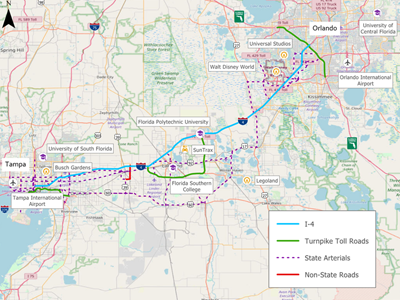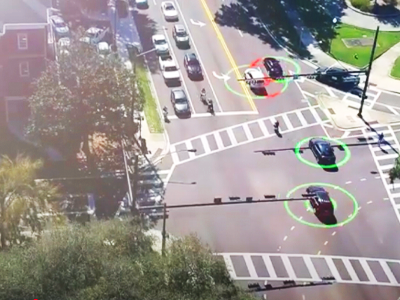The Florida Department of Transportation’s (FDOT) Connected and Automated Vehicle (CAV) program is leading the way in improving transportation across the state by using modern systems that help vehicles and roads work better together. CAVs can communicate with each other and the roadways and aim to make roads safer, reduce traffic, and support Florida’s economy. By using tools like real-time traffic monitoring, communication between vehicles and road systems (Vehicle-to-Everything or V2X), and smart infrastructure, FDOT is building a transportation system that is not only more efficient but also flexible enough to meet the changing needs of motorists and communities.
FDOT CAV Program: Smarter, Safer, Connected
FDOT has launched a wide range of CAV programs across the state. Learn about several notable examples from the CAV program:
Deployment Projects

I-4 FRAME
I-4 FRAME, or Florida’s Regional Advanced Mobility Elements, enhances safety and mobility along I-4 using V2X communications – allowing vehicles to wirelessly communicate with other vehicles, traffic signals, roadways, pedestrians, and network systems – adaptive signal control, and real-time data sharing.

Gainesville SPaT Trapezium
Focuses on Signal Phase and Timing (SPaT) data sharing – digital data that describes the current state and timing of traffic signals at an intersection – to improve traffic flow and pedestrian safety.

Lake Mary Boulevard Connected Vehicle Project
Implements connected vehicle technologies to improve traffic signal coordination and safety.

SR 710/Beeline Highway CAV Freight Project
Aims to improve freight movement efficiency and safety using CAV technologies.
Research Projects

Gainesville Pedestrian-Bicyclist Connected Vehicle Pilot
Uses smartphone apps and V2X to improve safety for non-motorized road users around the University of Florida

Smart Bay US 98
Assesses safety and mobility improvements from CAV deployment along a 32-mile corridor in Bay County.
Infrastructure & Corridor Projects

Gainesville Pedestrian-Bicyclist Connected Vehicle Pilot
Implements smart signal systems and connected vehicle infrastructure to improve corridor efficiency or how effectively traffic flows along a major roadway.

Florida Keys COAST
Establishes connectivity between various modes of transportation and a traffic signal system.

SR 434 Connected Vehicle Deployment
Deploying connected vehicles while also collecting signal performance data, as part of the broader pedestrian initiative.
These projects demonstrate how FDOT is actively applying innovative solutions to real-world transportation challenges.
To keep both the incoming and outgoing data safe, FDOT uses the Security Credential Management System (SCMS), which ensures secure and trusted communication between vehicles, and infrastructure, protecting users from cybersecurity threats.
FDOT’s commitment to connected mobility goes beyond technology, fostering a future-ready, data-driven transportation ecosystem through collaborative and innovative research, planning, strategic pilot projects, and full technology deployments that enhance safety and efficiency. FDOT’s efforts are helping to redefine how people move, interact, and experience travel across the Sunshine State.

